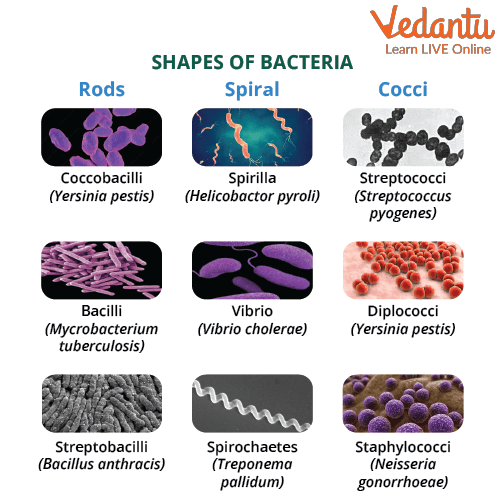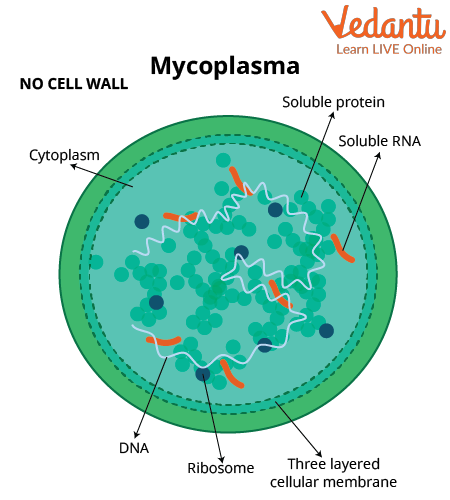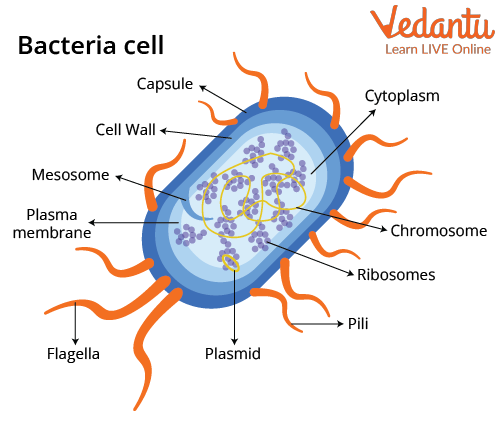




What is Kingdom Monera?
Before we start with the classification and characteristics of Monera, let us first discuss what is Monera? Monera is a biological kingdom in which all the prokaryotes are grouped together. Prokaryotes are organisms that do not have a nucleus and other organelles.
R.H. Whittaker proposed a Five Kingdom Classification in 1969. The kingdoms he defined were the names Monera, Protista, Fungi, Plantae and Animalia. The main criterion for the classification used by him includes the cell structure, body organisation, mode of nutrition, reproduction and phylogenetic relationships. Bacteria are the sole members of the Kingdom Monera that are the most abundant microorganisms. Members of Monera may not always be a bacterium, but a bacterium would be considered a moneran.
Monerans are directly beneficial to humans as they are utilized in the fermentation process, which helps make foods such as yogurt and cheese. Monera is also found naturally in our intestines and helps with the digestion of food.
Characteristics of Kingdom Monera
Monerans belong to the prokaryotic family and are unicellular organisms.
They have 70S ribosomes, which are composed of small 30S and large 50S subunits.
They lack a nucleus, hence their DNA is naked and is not bound by a nuclear membrane.
They also lack organelles such as mitochondria, lysosomes, plastids, Golgi bodies, endoplasmic reticulum, centrosome, and so on.
Their cell wall is made up of peptidoglycan and is rigid in nature.
Bacteria
Bacteria are present almost everywhere as they are the oldest organisms on earth. They live in extreme habitats where very few other life forms can survive such as hot springs, snow, deserts and deep oceans. Many of them also live as parasites which are present either on or in the body of other organisms (host).
They exhibit various shapes such as spherical Coccus, rod-shaped bacillus, comma-shaped Vibrum and spiral spirillum, and so on.

Shapes of Bacteria
Nutrition in Bacteria
They show the most extensive metabolic diversity. The following are the four nutritional categories found in bacteria:
Autotrophs: Synthesise their own organic food.
Saprotrophs: Feed on dead organic matter.
Symbionts: Use food from other living organisms with which they have a mutual relationship
Parasites: Absorb food from living organisms and cause harm to them
Respiration in Bacteria
Respiration in bacteria may be either of the two types:
Aerobic: Using oxygen for respiration
Anaerobic: Respiration in the absence of oxygen
Monera Kingdom Classification
Monera are classified into two categories: Archaebacteria and Eubacteria.
1. Archaebacteria
Archaebacteria are special, as they live in some of the harshest habitats such as extreme salty areas (halophiles), hot springs (thermoacidophiles) and marshy areas (methanogens). They are prokaryotic microorganisms that are believed to be the first form of life on the planet. They have a different cell wall structure that makes them different from other bacteria. Their cell wall is responsible for their survival in extreme conditions.
Methanogens are archaebacteria which are present in the gut of several ruminant animals such as cows and buffaloes. These methanogens are responsible for the production of methane (biogas) from the dung of these animals.
2. Eubacteria
Eubacteria are prokaryotic microorganisms consisting of a single cell that lacks a nucleus and contains DNA which is a single circular chromosome. They are also called True bacteria. They have rigid cell walls and a thread-like structure called a flagellum that helps in mobility.
Classification of Eubacteria
Based upon the mode of nutrition, they are classified into 3 categories:
Photosynthetic autotrophs: Bacteria that make their own food through the process of photosynthesis are called phototrophic autotrophs such as cyanobacteria, which are also called blue-green algae. They have chlorophyll similar to green plants. They are unicellular, colonial or filamentous, freshwater/marine or terrestrial algae. The colonies of cyanobacteria are generally surrounded by a gelatinous sheath that makes a homogenous surface around the cells.
Chemosynthetic autotrophs: The bacteria that oxidise various inorganic substances such as nitrates, nitrites and ammonia, and also use the released energy for their ATP production are called chemosynthetic autotrophs. These bacteria play a great role in recycling nutrients such as nitrogen, phosphorus, iron and sulphur.
Heterotrophic bacteria: The bacteria that use organic carbon as food are called heterotrophic bacteria. These bacteria are abundant in nature and the majority of them are decomposers. They also have a significant impact on human affairs as they help in making curd from milk, production of antibiotics, fixing nitrogen in legume roots, and so on. Some act as pathogens that cause damage to human beings, crops, farm animals and pets. Cholera, typhoid and tetanus are well-known diseases caused by different bacteria.
Monera Kingdom Organisms
The Monera kingdom contains all the single-celled organisms also called eukaryotes that do not possess a true nucleus. Monera kingdoms are commonly referred to as bacteria which involve organisms such as eubacteria, cyanobacteria, proteobacteria, spirochaetes, and so on.
Unique Features of Kingdom Monera
Monerans are unicellular prokaryotes that do not have a well-defined nucleus and other membrane-bound organelles except ribosomes. Their genetic material is not surrounded by a nuclear membrane; instead, they have a single piece of DNA present either in a linear form or circular form. They also don’t have membrane-bound organelles such as the Golgi body, mitochondria, endoplasmic reticulum, etc. They contain ribosomes as membrane-bound organelles.
Monera Examples
All bacteria including E. coli, Helicobacter pylori, salmonella etc, blue-green algae, Methanogens, and so on.
Mycoplasma
One of the members of Monera lacking a cell wall is Mycoplasma. These bacteria are the smallest living cells known and can survive without oxygen. Many mycoplasmas are pathogenic in nature and cause harm to living organisms.

A Mycoplasma
Reproduction in Monera
Monera reproduces asexually through the process of binary fission during favourable conditions and sometimes even reproduces through endosperm formation during unfavourable conditions. They also reproduce sexually by the process of conjugation.
Structure of Monera

Structure of a Bacterial Cell
All prokaryotes have a cell wall surrounding the cell membrane that protects the cell except mycoplasma, which lacks a cell wall. Each bacterial cell contains a membrane situated just internal to the cell wall called the plasma membrane. The fluid matrix filling the cell is called cytoplasm. There is no well-defined nucleus in prokaryotes. The genetic material is basically naked and is not enveloped by a nuclear membrane.
In addition to the genomic DNA (the single chromosome/circular DNA), many bacteria have small circular DNA outside the genomic DNA. These smaller DNAs are called plasmids. No organelles, like the ones found in eukaryotes, are present in the prokaryotes except ribosomes. Prokaryotes have something unique in the form of inclusions.
A specialised differentiated form of the cell membrane called mesosomes is the characteristic of prokaryotes; these are essentially infoldings of the cell membrane. They also have a thread-like structure called flagella that helps them to swim. Apart from flagella, they also have some tiny or small hairlike outgrowths called pili.
Conclusion
This article has given all the necessary detail about the Kingdom Monera with respect to the NEET syllabus. The questions added at the end of the article are frequently asked questions and are important from the exam point of view thus the student can have a clearer understanding of the type of questions that might appear in the exam.
Essential Study Materials for NEET UG Success
FAQs on Kingdom Monera And Its Characteristics
1. How many questions are typically asked on the topic of Kingdom Monera?
As kingdom Monera is an important topic from the exam point of view, around 2-3 questions are usually asked in the NEET exam every year. The questions are pretty basic, so make sure to brush up on your basics and remember the common things on tips such as exceptions in bacteria that lack cell walls, organelles present in eukaryotes, and arrangement of genetic material in eukaryotes. A student must draw a table to learn concepts clearly about the difference in features of the different kingdoms.
2. What are the main points to remember from the topic Kingdom Monera?
Specifically for the NEET exam, there are important concepts to remember such as various features of Monera, reproduction in Monera, and examples of Monera including the exceptions. Characteristics and features of this kingdom, life processes features, mode of nutrition, different kinds of bacteria, and their shapes. Functions and features of these organisms are some kinds of good and frequently asked topics from this kingdom. A student must revise NCERT several times to hold a firm grip of the concepts and fetch a high score in NEET.
3. What is the Kingdom Monera?
Kingdom Monera consists of unicellular prokaryotic organisms, including bacteria and cyanobacteria, that lack a true nucleus and membrane-bound organelles.
4. What are five examples of Kingdom Monera?
Five examples of Kingdom Monera are Escherichia coli (E. coli), Streptococcus, Salmonella, Clostridium, and Cyanobacteria (Blue-green algae).
5. What is the definition of Monera?
Monera is a biological kingdom that includes unicellular, prokaryotic microorganisms such as bacteria and archaea, characterized by the absence of a true nucleus and membrane-bound organelles.
6. How many organisms are in the Kingdom Monera?
Kingdom Monera includes millions of species of bacteria and archaea, forming a diverse group of microscopic organisms.
7. What animal is in the Kingdom Monera?
There are no animals in Kingdom Monera, as it consists only of unicellular prokaryotic microorganisms like bacteria and cyanobacteria.
8. What do Moneras eat?
Moneras obtain energy in various ways, including autotrophic (photosynthesis or chemosynthesis) and heterotrophic (saprophytic, parasitic, or symbiotic) nutrition.
9. What is the size of Monera?
Monera are microscopic in size, typically ranging from 0.1 to 5 micrometers (µm) in diameter.










